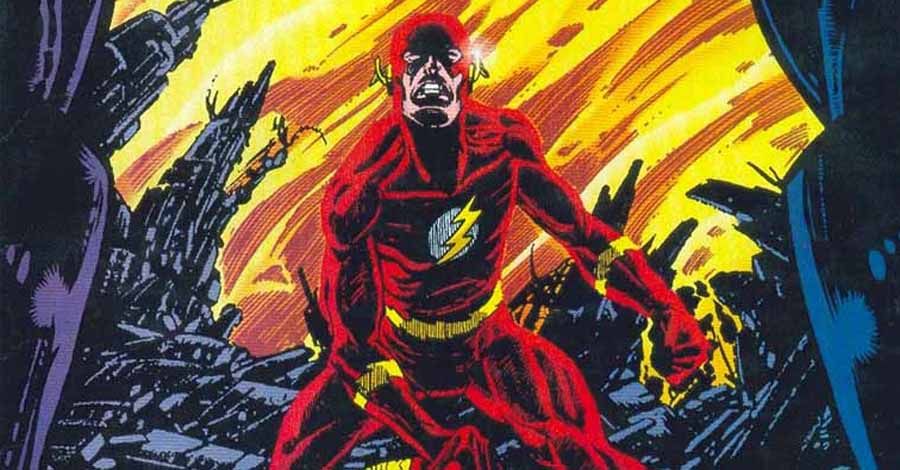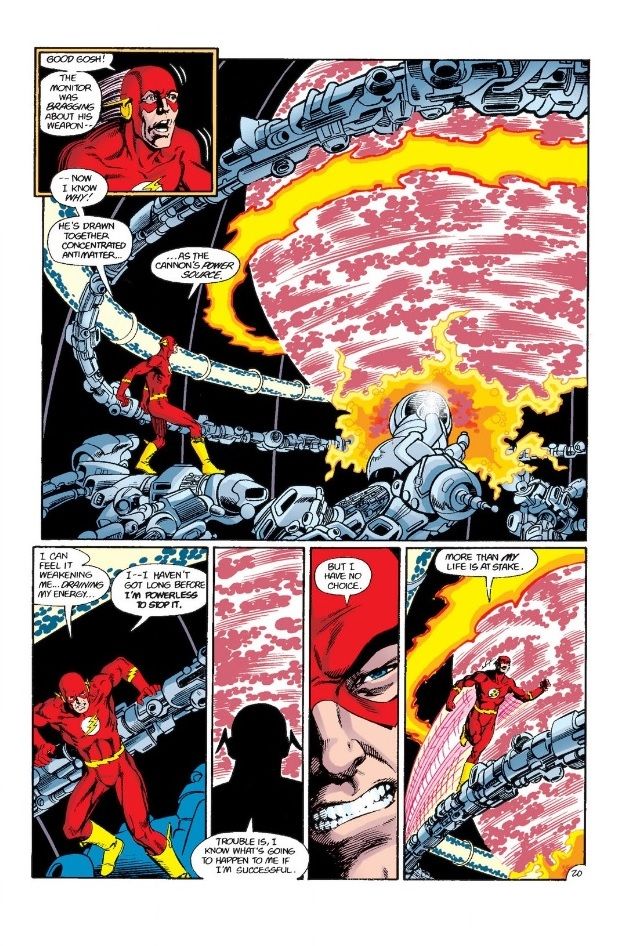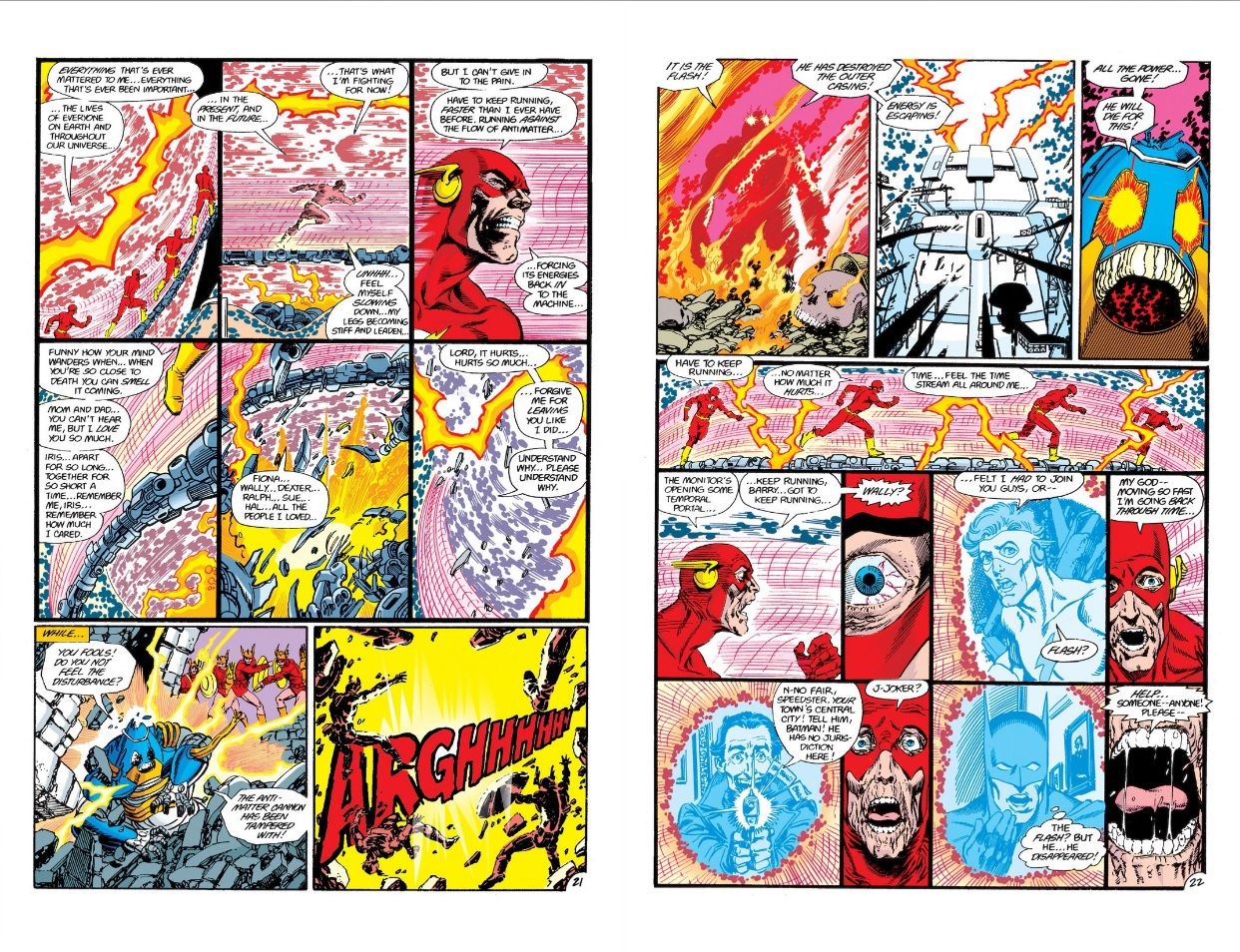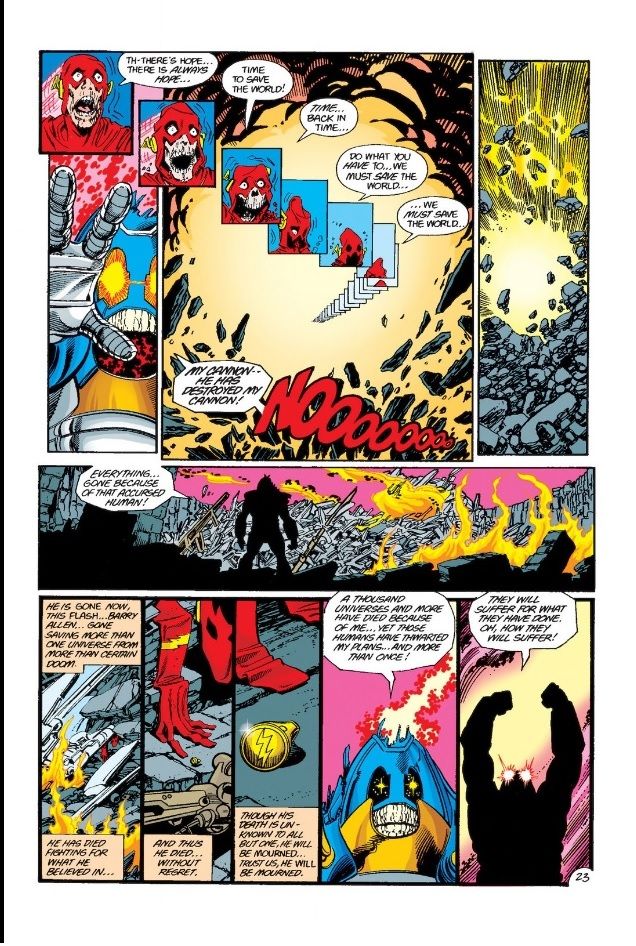Cover-billed as “The Final Fate of The Flash,” Crisis on Infinite Earths #8 -- which appeared in comics stores 30 years ago this month, during the first week of July 1985 -- takes a while to get to the point. When last we saw the Anti-Monitor, in Issue 7, his citadel had been destroyed and he’d been forced to flee in some sort of rough-hewn spaceship. Thus, Issue 8 opens with a two-page sequence aboard Anti-M’s vessel and features Psycho-Pirate, Anti-Monitor, and the Flash; but after that they don’t appear again until Page 14.
Indeed, much of that gap is filled with six pages of digressions involving (among others) Firehawk, Blue Devil, Green Lantern and the apparently final fate of the android Red Tornado. As overstuffed as Issue 7 felt, with the origins of the Multiverse and various cosmic players, and the big battle culminating in Supergirl’s sacrifice, this issue seems rather thin. Still, the main event remains powerful, even knowing how it plays out, and even taking into account Barry Allen’s eventual return.
We’ll get to all that, of course; but first let’s take care of the credits. Issue 8 was written and edited by Marv Wolfman, co-plotted and penciled by George Pérez, inked by Jerry Ordway, colored by Anthony Tollin, and lettered by John Costanza. Bob Greenberger was the associate editor and Len Wein was the consulting editor.
* * *
Here’s a brief summary of the issue’s non-Flash subplots:
- Page 3: Darkseid and Desaad reveal that Apokolips has been “cloaked” from Anti-M the whole time, so that Darkseid can destroy whomever comes out on top.
- Page 4: On Oa, following the big explosion in Issue 5, the Guardians argue about what to do next while assorted Green Lanterns look on in confusion.
- Page 5: At Legion headquarters, Brainiac 5 (who carried a big torch for Supergirl) throws himself into his work.
- Page 6: Firehawk seeks out Firestorm, who for some reason is moping after Killer Frost “broke up with him” (i.e., after Psycho-Pirate’s spell wore off). Vixen summons Firestorm to the Justice League Satellite, because she’s found Red Tornado’s creator T.O. Morrow and he’s got some repairs to do.
- Pages 7-8: Assorted Leaguers (Firestorm, Martian Manhunter, the Atom, Vixen), along with Firehawk, Morrow and Cyborg, discover that Reddy’s innards are all-new and all-different.
- Pages 9-10: Green Lantern (John Stewart) and Blue Devil come aboard the JLA Satellite, because BD also has some cybernetics experience. However, just as he yells a warning, Reddy explodes, and the assembled heroes head for the exits.
- Pages 11-13: Firehawk whips up a new suit, since her old one got burned up. (She’s the only one to have suffered thusly.) A blast catches Martian Manhunter, which makes me think perhaps he was on the “permanently retire” list at some point. However, everybody but Blue Devil (and Red Tornado) seems fine. For his part, Blue Devil gets sucked into an interdimensional vortex and winds up halfway across the galaxy on the Omega Men’s starship. Naturally, a footnote informs us that it’s To Be Continued in Blue Devil #18.
Each of these vignettes has its own pros and cons. Probably the most innocuous are the Darkseid and Legion interludes. Apparently the Fourth World was always questionable at best for Crisis, in part because Jack Kirby’s Hunger Dogs graphic novel -- which was supposed to wrap everything up -- was also due out in 1985. As for the Legion, checking in with them facilitated some exposition and a couple of character moments. However, the rest seemed to wander too far afield. Even if you thought Firestorm pining for Killer Frost was unexpectedly poignant (and part of me thinks it kinda was), it probably didn’t deserve three-quarters of a page. Likewise, the Red Tornado subplot needed to be either a big deal in Crisis itself, or a good hook for a spinoff. Just blowing him up after three issues was anticlimactic. Justice League of America Annual #3 offered some closure for this particular chapter in the character’s history, but within a few years he was pretty much back to his old self.
The Green Lantern Corps’ subplot also picks up after three issues; and their treatment herein is a little more frustrating. Admittedly, at this point Green Lantern writer Steve Englehart was weaving his own set of parallel Crisis-related adventures involving John Stewart, Katma Tui, and ex-Lanterns Hal Jordan and Guy Gardner; and these would have been rather difficult to integrate into Crisis proper. Still, in issue #5 the Central Power Battery appears to explode, right in front of a dozen Lanterns and the immobilized Guardians; and in issue #8 everyone’s just a little bruised. If there’s one thing Infinite Crisis did to improve on its inspiration, it was to involve the Corps a lot more heavily. In any event, the Guardians’ internal conflict seems to come down to the old “let’s not wait for something to happen” question, about which we’ll learn more next issue.
* * *
But of course, we still have to talk about this issue’s big bit of business, the heroic sacrifice (spoilers!) of one Bartholomew Henry Allen. It’s not much of a stretch to say that the Flash’s entire role in Crisis centers around this sequence. Kidnapped by Anti-M in Issue 3 specifically because only he could travel between parallel worlds unaided -- I suppose Jay Garrick was getting too old, and Wally West’s puberty was turning his super-speed against him -- like the Green Lanterns he’s been off the table for most of the miniseries. What’s more, as far as the rest of the superhero line was concerned both the Flash and The Flash had all but faded away. Flash #350 (published the month before) wrapped up the years-long “Trial of the Flash” storyline by a) acquitting our hero, b) revealing that Iris Allen was not dead, just living in the just-before-the-Legion 30th century, and c) reuniting the Allens so they could race into the sunset together. Both character and series got a satisfying sendoff, allowing this issue of Crisis to stand somewhat apart.
The Flash sequence doesn’t really start until just after the issue’s halfway point, and the issue itself ends on a semi-related two-page coda. That said, I’m pretty sure its ten pages comprise Crisis’ longest continuous sequence devoted to a single character. (Even Supergirl’s death was just part of a bigger battle.) Like the Flash himself, these 10 pages are elegant in their collective simplicity. All the Flash does -- once he frees himself from a gelatinous prison, takes out his frustrations on Psycho-Pirate, and gets the emotive evildoer in a headlock -- is run fast. Really, really fast.
See, Flash has to destroy Anti-M’s new antimatter cannon, currently under construction on Qward. The cannon represents Anti-M’s third method to date for destroying any and all positive-matter universes, after 1) the implacable antimatter cloud of the first six issues, and 2) the device Supergirl destroyed last issue, which was forcing the five remaining universes together so that they would explode. With the cannon, apparently Anti-M has decided to take the advice of countless armchair critics, and just shoot something instead of devising another elaborate deathtrap.
It also means that Flash can spend eight of those 10 pages on what’s essentially an extended monologue. Forced out of blissful retirement, held captive for who-knows-how long, and tormented by Psycho-Pirate and Anti-Monitor the whole time, Flash clearly has a lot on his mind. When he races down from the dungeon wall and starts pummeling the Pirate, the floodgates burst. He goes from rage (“For weeks now you’ve done everything to humiliate me! Everything to destroy me!”) to desperation (“I was convicted once of a murder I didn’t commit -- what difference would it make if I committed it now?”) to steely resolve in a matter of seconds.
Using Psycho-Pirate’s powers to turn the Qwardian Thunderers against Anti-Monitor, Flash distracts the bad guys long enough to reach the gigantic cannon. He then vibrates through the cannon’s outer shell and, seeing the concentrated antimatter powering it, realizes that forcing the antimatter back upon itself is the only way to destroy the cannon. Of course, this involves billions of super-speed laps, during which Flash essentially narrates his own demise.
If it sounds maudlin, it is; but Wolfman manages to make it convincing. Only after his death did Barry Allen really become the Squarest Man Alive. During his life he was basically a good guy with an incredible gift. He worked a regular job, he married his steady girlfriend and came home to her every night (where feasible), his nephew was his protegé and his best friends were superheroes. He didn’t have a secret headquarters, an otherworldly heritage, or an encyclopedic array of powers and/or gear. He just ran really fast, and sometimes it helped that he was really smart.
Thus, when he addresses his absent loved ones -- his parents, Iris, his ex-fianceé Fiona, Wally West, Hal Jordan, Ralph and Sue Dibny, Flash Museum curator Dexter Myles -- it reminds the reader of the relationships Barry built, and those he leaves behind. “Forgive me for leaving you like I did,” he pleads, as if the choice were to die at home or die alone in the heart of an evil universe. In stories like these, clearly there is no choice. Besides, Barry already got his happy ending.
Eventually Flash runs so fast he breaks the time barrier, apparently running into the future to catch a heretofore-untold glimpse of Kid Flash, and then into the past to encounter Batman and the Joker in Issue 2. (Surprisingly, this lets us hear Batman’s thoughts.) As his body finally crumbles away, leaving only his costume and ring, Flash speaks of hope -- a familiar Wolfman theme for this series -- and intones “We must save the world ... we must save the world....” As Pérez zooms in on what remains, Wolfman’s omniscient narration picks up from here: “He has died fighting for what he believed in ... And thus he died ... without regret.”
It takes four pages to destroy the cannon, and for the most part Pérez’s layouts don’t deviate too far from a standard grid. The storytelling comes largely from the various camera angles and closeups, which themselves are arguably necessary because Flash is basically running in circles in hopes that something productive will happen. This ends up putting the reader at a certain distance from the action, which I suppose emphasizes the singularly solitary nature of Flash’s task. He’s been isolated from his colleagues for most of the miniseries, and none of them will ever know exactly what happened (although a time-traveling Wally West will get a good idea several years later, around Issue 150 of his own Flash volume). Essentially, there’s no help coming, and nothing the reader can do but watch Flash run out his life. This choice of storytelling also leaves ample room for Wolfman’s dialogue, but I’m not sure who was trying to complement whom.
After the cannon explodes, Anti-M rages at the heavens, drawing into himself all the antimatter energy of “more than one million worlds” (and their inhabitants), in order to fuel a trip through time. For most of this issue, Pérez has been depicting antimatter energy with some form of Kirby Dots, occasionally accompanied by Kirby Krackle and usually colored a dirty red or purple. Accordingly, when we cut to the Challengers of the Unknown, running tests in their headquarters to see what sort of cosmic energies are going to zap them next, the sky and even space itself turns dirty-pink and crackly . How bad is it? The final page shows the Spectre screaming in frustration, unable to stop Anti-M’s temporal journey.
* * *
Overall, this issue seems pulled in two different directions. The non-Flash vignettes show that even with their five Earths still stuck together, the superheroes are (temporarily) taking a collective break from trying to save what’s left. See, e.g., Firestorm moping atop a water tower and Blue Devil sunbathing. At least the Challengers are watching out for the next big disaster.
Speaking of which, it’s a happy coincidence that this issue features a few Jack Kirby creations, namely Darkseid, Desaad, and the Challengers. They’re almost bookends of Kirby’s DC work. The Challs predated the Fantastic Four but clearly contributed to the FF’s overall aesthetic, and of course Darkseid and company were some of the King’s last creations for DC. In fact, with the Flash, Green Lantern, and the Justice League also spotlighted, this issue is full of nods to early Silver Age successes. The Challs remind us that those successes helped inspire Marvel as well.
Like Issue 7, this issue ends with a brief, Flash-appropriate epitaph (“The Flash, 1956-1985"). As far as the regular ongoing comics were concerned, Barry Allen was staying dead, although he popped up in “untold tales” like JLA: Year One and Legends of the DC Universe. Around the time of the aforementioned Flash Vol. 2 #150, writer Mark Waid found a way for Barry to interact with his successors: just have them visit him (or vice versa) in his 30th Century home. Thanks to the Speed Force, Barry also found a way to participate in 2005-06's Infinite Crisis; and returned for good in 2008-09's Final Crisis. The New 52 reboot installed Barry firmly as DC-Earth’s only Scarlet Speedster (Jay Garrick having been rebooted himself along with the rest of Earth-2), and as we all know he’s now a big TV star. (Funny how the two best-known characters killed in Crisis will both be on your TV screen this fall ...)
Next up, as Crisis on Infinite Earths enters its last third, the “Villain War” erupts! Who said August is a dull month?




